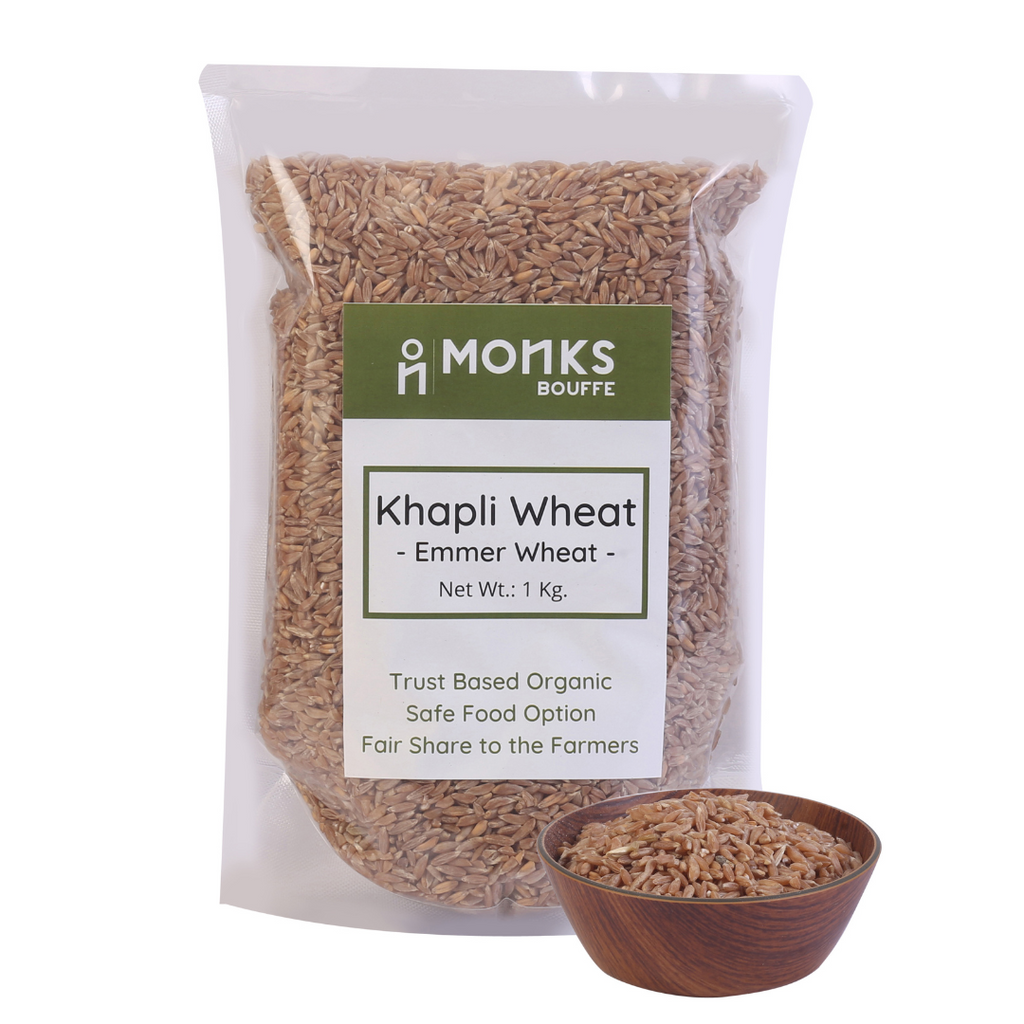Additional 5% OFF on First Order
Use Code: FIRSTORDER5
15% OFF on Nut Butters
Use Code: NUTBUTTER15
₹150/- OFF on order above ₹2999.
Use Code: 150OFF
₹350/- OFF on order above ₹4999.
Use Code: 350OFF

Monks Bouffe
MRP
Select Option
Product of Regenerative Farming
Traditionally Processed
Freshly Packed on order
Premium Quality
Ships in 1-2 business days pan India
Quantity: 20Kg
Naturally Grown
The Monks Bouffe Khapli wheat is an heirloom variety of khapli grown in the Parbhani region of western Maharashtra. It is exclusively grown by our farmer friends using natural farming practices.
Reviving this ancient variety
It is speculated that Khapli wheat came to Northern India (Kashmir) from the Persia & Afghanistan region of the Middle-east. While it reached Southern India by the sea route from North Eastern Africa. Khapli has been grown on our land for over 10,000 years though the revival of this nutritious variety has just begun once again. A large number of farmers especially in Maharashtra have now started growing this ancient variety.
Easy to Digest
Moving away from the common belief that wheat is difficult to digest, the low gluten content and the low glycemic index make khapli comparatively easy on the stomach & easier to digest. Many doctors, nutritionists and dieticians have now started recommending Khapli wheat for daily use when it comes to flat bread like rotis, chapattis or parathas.
Traditional Processing of Khapli Wheat
Step 1: The Spikenet when hard is harvested and soaked in water.
Step 2: It is then dried (the number of days depends on the region)
Step 3: Fiercely thrashed to free the seeds.
Step 4: The seeds are once again soaked and dried.
Step 5: The seeds are then thrashed again to get the long thin edible meal of Khapli
6 Key Benefits Of Khapli Wheat
1. Low Glycemic Index
2. Rich in Fibre
3. Easy to Digest
4. Rich in Vitamins & Minerals
5. Good source of Proteins
6. Good source of antioxidants.
FAQ:
1. 1. Is Khapli/Emmer Wheat Gluten Free?
A: As per general messaging Khapli has been said to have 'No Gluten Content', though Khapli is a wheat variety with minimal gluten content.
2. What is gluten?
A: Gluten is a protein found in wheat. The word gluten comes from the latin word "glue" that means to hold together. It acts as a binding agent to keep the food together and give it the required consistency. Some people may have issues with digesting the gluten in wheat. And therefore they may be suggested to consume a wheat variety that is low in gluten. Khapli/Emmer wheat being one of the options.
3 What is the difference between Khapli & other wheat varieties?
A: Khapli Wheat has the following difference compared to other wheat varieties:
> Lower Gluten content
> Low Glycemic Index
> Longer Grain size
> More fibre content
> Reddish colour as compared to brown for other wheat varieties
4. Is Khapli Wheat easy to digest?
A: Khapli Wheat has high fibre and low gluten content which makes it easier to digest as compared to other wheat varieties.
5. What is the gluten content in Khapli Wheat?
A: The gluten content in Khapli Wheat is anywhere between 1%-3% only.
Size Guide:
1Kg Khapli Wheat = 40 No Of Gujarati Chapatis or 10 Bowls Of Halwa or 40 Servings Of Porridge
History Can Be Fun to Know!!
> The earliest evidence of cultivation of Khapli wheat comes from the Neolithic archaeological site of Mehrgarh (6000-5000 BCE)
> The archaeological findings in Haryana, Kanishkapura in Kashmir, Harappan settlement of Rohira in Punjab also show evidence of Khapli cultivation